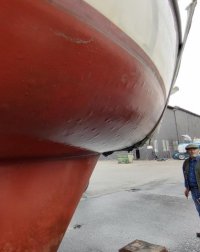SteveOO
Member I
I’m looking at a 1980 38 footer for sale. It’s in generally good shape, but there are fairly large blisters on the hull. I’ve read a lot of conflicting opinions on if blisters ever actually a potential structural danger, or merely cosmetic (meaning they don’t penetrate the woven fibers because that layer is inert, and gel coat and mat layer intrusions don’t actually affect structural integrity). The survey notes these blisters, but they aren’t mentioned in the corrective action section. Same goes for a spliced mast with rivets. I’ve lived and worked on commercial fishing boats for years, but am a first time sailboat buyer, so I’m not sure how big of red flags these 2 issues may be. The boat valuation is $36k on the low end (per the survey) and it’s listed at $28k, so I am willing to spend $5k or a bit more on initial repairs (not counting ongoing maintenance of a 40 yr old boat). 

